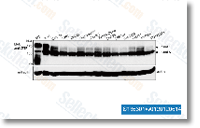Vasoconstriction, oxygen derived free of charge radicals, reduction of proximal tubular cell polarity and infil tration of adhesion molecules, which result in impairment of cell cell and cell matrix adhesion structures, have been shown for being implicated in the pathogenesis of renal I R injury. Acute inflammatory responses initi ated in the course of ischemia and reperfusion, characterized by the induction of an inflammatory cytokine cascade, ex pression of adhesion molecules and cellular infiltration, cause necrosis and apoptosis of renal cells. Dexmedetomidine is between various prophylactic and therapeutic measures which were used to cut back perioperative AKI. It can be a really selective 2 adrenoreceptor agonist with sedative, anal gesic, sympatholytic and hemodynamic stabilizing prop erties. Current research propose that dexmedetomidine has organoprotective results, cutting down cerebral, cardiac, intestinal and renal damage which may be abolished by atipamezole, an two adrenoreceptor antagonist.
The 2 adrenoreceptors are widely distributed additional reading from the renal proximal and distal tubules, peritubular vascula ture likewise as in systemic tissues. Dexmedetomidine treatment selleck chemical SB 431542 has become noticed to inhibit vasopressin secretion, enhance renal blood flow and glomerular filtration, and in crease urine output. Dexmedetomidine also includes a cytoprotective effect towards renal I R injury. The combin ation of these aforementioned properties may possibly contribute to enhancing renal perform beneath ischemic disorders. On the other hand, the underlying molecular mechanisms of dexmedetomidines renoprotection continue to be unknown. It’s probable that activation of Janus kinase signal transducer and activator of transcription pathway is concerned during the development of renal I R in jury, throughout which quite a few pro inflammatory cytokines are up regulated.
The JAK STAT pathway is  composed of a family members of receptor related cytosolic tyrosine ki nases that phosphorylate a tyrosine residue on bound transcription aspects. JAK mediated tyrosine phosphorylation of STAT relatives members en ables translocation of these transcription variables towards the nucleus and result in an augmentation of gene transcrip tion. The putative JAK2 inhibitor AG490, which induces inactivation of downstream STATs, protects towards ischemia induced acute renal damage. STAT3 knockout animals have exposed the pleiotropic part of STAT3 in many organs and cell varieties like the heart, skin, T lymphocytes, monocytes neutrophils, mammary epithelium, liver and neurons following is chemia. It’s been confirmed recently that STATs, present within the mitochondria, modulate mitochondrial respiration, regulate mitochondria mediated apoptosis and inhibit the opening of mitochondrial permeability transition pores. Of all of the JAK STAT pathways, JAK2 signaling via STAT1 and STAT3 will be the perfect studied in diseases affecting the kidney.
composed of a family members of receptor related cytosolic tyrosine ki nases that phosphorylate a tyrosine residue on bound transcription aspects. JAK mediated tyrosine phosphorylation of STAT relatives members en ables translocation of these transcription variables towards the nucleus and result in an augmentation of gene transcrip tion. The putative JAK2 inhibitor AG490, which induces inactivation of downstream STATs, protects towards ischemia induced acute renal damage. STAT3 knockout animals have exposed the pleiotropic part of STAT3 in many organs and cell varieties like the heart, skin, T lymphocytes, monocytes neutrophils, mammary epithelium, liver and neurons following is chemia. It’s been confirmed recently that STATs, present within the mitochondria, modulate mitochondrial respiration, regulate mitochondria mediated apoptosis and inhibit the opening of mitochondrial permeability transition pores. Of all of the JAK STAT pathways, JAK2 signaling via STAT1 and STAT3 will be the perfect studied in diseases affecting the kidney.
No related posts.
